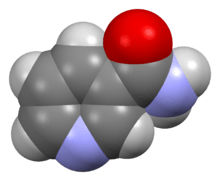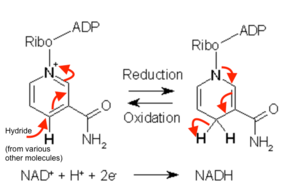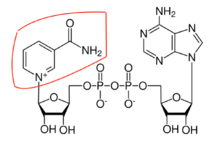Nicotinamide
 | |
 | |
| Clinical data | |
|---|---|
| Pronunciation | /ˌnɪkəˈtɪnəmaɪd/ |
| AHFS/Drugs.com | Consumer Drug Information |
| Pregnancy category |
|
| Routes of administration | by mouth, topical |
| ATC code | |
| Legal status | |
| Legal status |
|
| Identifiers | |
| |
| Synonyms |
3-pyridinecarboxamide niacinamide nicotinic acid amide vitamin PP nicotinic amide vitamin B3 |
| CAS Number | |
| PubChem CID | |
| DrugBank | |
| ChemSpider | |
| UNII | |
| KEGG | |
| ChEBI | |
| ChEMBL | |
| ECHA InfoCard | 100.002.467 |
| Chemical and physical data | |
| Formula | C6H6N2O |
| Molar mass | 122.13 g·mol−1 |
| 3D model (JSmol) | |
| Density | 1.40 g/cm3[2] g/cm3 |
| Melting point | 129.5 °C (265.1 °F) |
| Boiling point | 334 °C (633 °F) |
| |
| |
Nicotinamide (NAA), also known as niacinamide, is a vitamin found in food, used as a dietary supplement, and used as a medication.[3][4][5] As a supplement, it is used by mouth to prevent and treat pellagra (niacin deficiency).[4] While nicotinic acid (niacin) may be used for this purpose, nicotinamide has the benefit of not causing skin flushing.[4] As a cream, it is used to treat acne.[5]
Side effects are minimal.[6][7] At high doses liver problems may occur.[6] Normal amounts are safe for use during pregnancy.[1] Nicotinamide is in the vitamin B family of medications, specifically the vitamin B3 complex.[8][9] It is an amide of nicotinic acid.[6] Foods that contain nicotinamide include yeast, meat, milk, and green vegetables.[10]
Nicotinamide was discovered between 1935 and 1937.[11][12] It is on the World Health Organization's List of Essential Medicines, the most effective and safe medicines needed in a health system.[13] Nicotinamide is available as a generic medication and over the counter.[8] In the United Kingdom a 60 g tube costs the NHS about £7.10.[5] Commercially nicotinamide is made from either nicotinic acid or 3-cyanopyridine.[12][14] In a number of countries grains have nicotinamide added to them.[12]
Medical uses
Niacin deficiency
Nicotinamide is the preferred treatment for niacin deficiency (pellagra).[4] A patient's diagnosis of pellagra is based on their history, as well as a presence of dermatitis, diarrhea, and dementia.[15] While nicotinic acid (niacin) may be used, nicotinamide has the benefit of not causing skin flushing.[4]
Acne
Nicotinamide in the form of a cream is used as a treatment for acne.[5]
It has anti-inflammatory actions. These may be of benefit to people with inflammatory skin conditions.[16]
Nicotinamide increases the biosynthesis of ceramides in human keratinocytes in vitro and improves the epidermal permeability barrier in vivo.[17] The application of 2% topical nicotinamide for 2 and 4 weeks has been found to be effective in lowering the sebum excretion rate in study participants.[18] Nictotinamide has been shown to prevent Propionibacterium acnes-induced activation of toll-like receptor (TLR)-2, which ultimately results in the down-regulation of pro-inflammatory IL-8 production.[19]
Side effects
Side effects are minimal.[6][7] At high doses liver problems may occur.[6] Normal amounts are safe for use during pregnancy.[1]
Chemistry
The structure of nicotinamide consists of a pyridine ring to which a primary amide group is attached in the meta position. It is an amide of nicotinic acid.[6] As an aromatic compound, it undergoes electrophilic substitution reactions and transformations of its two functional groups. Examples of these reactions reported in Organic Syntheses include the preparation of 2-chloronicotinonitrile by a two-step process via the N-oxide,[20][21]
nicotinonitrile by reaction with phosphorous pentoxide,[22] and 3-aminopyridine by reaction with a solution of sodium hypobromite, prepared in situ from bromine and sodium hydroxide.[23]
Biological importance
Nicotinamide occurs as a component of a variety of biological systems, including within the vitamin B family and specifically the vitamin B3 complex.[8][9] It is also a critically important part of the structures of NADH and NAD+, where the N-substituted aromatic ring in the oxidised NAD+ form undergoes reduction with hydride attack to form NADH.[24] The NADPH/NADP+ structures have the same ring, and are involved in similar biochemical reactions.
Industrial production
The hydrolysis of 3-cyanopyridine (nicotinonitrile) is catalysed by the enzyme nitrile hydratase from Rhodococcus rhodochrous J1,[25][26][14] producing 3500 tons per annum of nicotinamide for use in animal feed.[27] The enzyme allows for a more selective synthesis as further hydrolysis of the amide to nicotinic acid is avoided.[28][29] Nicotinamide can also be made from nicotinic acid. According to Ullmann's Encyclopedia of Industrial Chemistry, world-wide sales of nicotinamide were 31,000 tons in 2014.[12]
Biochemistry

Nicotinamide, as a part of the coenzyme nicotinamide adenine dinucleotide (NADH / NAD+) is crucial to life. In cells, nicotinamide is incorporated into NAD+ and nicotinamide adenine dinucleotide phosphate (NADP+). NAD+ and NADP+ are coenzymes in a wide variety of enzymatic oxidation-reduction reactions the most notable being glycolysis, the citric acid cycle, and the electron transport chain.[24] If humans ingest nicotinamide, it will likely undergo a series of reactions that transform it into NADv, which can then undergo a transformation to form NADP+. This method of creation of NAD+ is called a salvage pathway. However, the human body can produce NAD+ from the amino acid tryptophan and niacin without our ingestion of nicotinamide.[30]
NAD+ acts as an electron carrier that helps with the interconversion of energy between nutrients and the cell's energy currency, ATP. In oxidation-reduction reactions, the active part of the coenzyme is the nicotinamide. In NAD+, the nitrogen in the aromatic nicotinamide ring is covalently bonded to adenine dinucleotide. The formal charge on the nitrogen is stabilized by the shared electrons of the other carbon atoms in the aromatic ring. When a hydride atom is added onto NAD+ to form NADH, the molecule loses its aromaticity, and therefore a good amount of stability. This higher energy product later releases its energy with the release of a hydride, and in the case of the electron transport chain, it assists in forming adenosine triphosphate.[31]
For every one mole of NADH that is oxidized, 158.2 kJ of energy will be released.[31]
Food sources
Nicotinamide occurs in trace amounts mainly in meat, fish, nuts, and mushrooms, as well as to a lesser extent in some vegetables.[32] It is commonly added to cereals and other foods. If one would want to take it orally, it is present in many multivitamins, and there are around 20–30 mg in each. It is also available as a standalone vitamin, in much higher quantities around 500 mg.[33]
Compendial status
Research
There is tentative evidence that it may reduce the risk of nonmelanoma skin cancers among people who have had a previous basal cell carcinoma or squamous cell carcinoma.[36] There is also tentative evidence for its effective use to treat bullous pemphigoid.[36] Nicotinamide may aid chemotherapy-and-radiation therapy by acting as a sensitizing agent/cancer-growth-promoter resulting in enhanced blood flow to tumors and thus increased oxygen supply to tumors, thereby reducing tumor hypoxia. Niacinamide also inhibits poly(ADP-ribose) polymerases (PARP-1), enzymes involved in the rejoining of DNA strand breaks induced by radiation or chemotherapy.[37] Niacinamide may beneficial in treating psoriasis.[38]
Nicotinamide can prevent and even reverse the progression of glaucoma in mice and slows, or even stops damage to retinal ganglion cells and their axons in the optic nerve. [39]
See also
References
- 1 2 3 "Niacinamide Use During Pregnancy". Drugs.com. Retrieved December 29, 2016.
- ↑ Record in the GESTIS Substance Database of the Institute for Occupational Safety and Health
- ↑ Bender, David A. (2003). Nutritional Biochemistry of the Vitamins. Cambridge University Press. p. 203. ISBN 978-1-139-43773-8.
- 1 2 3 4 5 WHO Model Formulary 2008 (PDF). World Health Organization. 2009. pp. 496, 500. ISBN 978-924-154765-9. Retrieved December 8, 2016.
- 1 2 3 4 British National Formulary: BNF 69 (69th ed.). British Medical Association. 2015. p. 822. ISBN 978-0-85711-156-2.
- 1 2 3 4 5 6 Knip, M.; Douek, I. F.; Moore, W. P.; Gillmor, H. A.; McLean, A. E.; Bingley, P. J.; Gale, E. A. (2000). "Safety of high-dose nicotinamide: A review". Diabetologia. 43 (11): 1337–1345. PMID 11126400. doi:10.1007/s001250051536.
- 1 2 MacKay, D.; Hathcock, J.; Guarneri, E. (2012). "Niacin: Chemical forms, bioavailability, and health effects". Nutrition Reviews. 70 (6): 357–366. PMID 22646128. doi:10.1111/j.1753-4887.2012.00479.x.
- 1 2 3 "Niacinamide: Indications, Side Effects, Warnings". Drugs.com. June 6, 2017. Retrieved June 30, 2017.
- 1 2 Krutmann, Jean; Humbert, Philippe (2010). Nutrition for Healthy Skin: Strategies for Clinical and Cosmetic Practice. Springer Science & Business Media. p. 153. ISBN 9783642122644.
- ↑ Burtis, Carl A.; Ashwood, Edward R.; Bruns, David E. (2012). Tietz Textbook of Clinical Chemistry and Molecular Diagnostics (5th ed.). Elsevier Health Sciences. p. 934. ISBN 978-1-4557-5942-2.
- ↑ Sneader, Walter (2005). Drug Discovery: A History. John Wiley & Sons. p. 231. ISBN 978-0-470-01552-0.
- 1 2 3 4 Blum, René (2015). "Vitamins, 11. Niacin (Nicotinic Acid, Nicotinamide". Ullmann's Encyclopedia of Industrial Chemistry (6th ed.). Weinheim: Wiley-VCH. ISBN 978-3-527-30385-4. doi:10.1002/14356007.o27_o14.pub2.
- ↑ "WHO Model List of Essential Medicines (19th List)" (PDF). WHO Model List of Essential Medicines. World Health Organization. 2015. Retrieved December 8, 2016.
- 1 2 Schmidberger, J. W.; Hepworth, L. J.; Green, A. P.; Flitsch, S. L. (2015). "Enzymatic Synthesis of Amides". In Faber, Kurt; Fessner, Wolf-Dieter; Turner, Nicholas J. Biocatalysis in Organic Synthesis 1. Science of Synthesis. Georg Thieme Verlag. pp. 329–372.
- ↑ Pitche, Palokinam T. (2005). "Pellagre et érythèmes pellagroïdes" (PDF). Cahiers Santé (in French). 15 (3): 205–208. PMID 16207585.
- ↑ Niren, N. M. (2006). "Pharmacologic doses of nicotinamide in the treatment of inflammatory skin conditions: A review". Cutis. 77 (1 (Supplement: Nicotinamide and Zinc in the Treatment of Acne and Rosacea)): 11–16. PMID 16871774.
- ↑ Tanno, O.; Ota, Y.; Kitamura, N.; Katsube, T.; Inoue, S. (2000). "Nicotinamide increases biosynthesis of ceramides as well as other stratum corneum lipids to improve the epidermal permeability barrier". The British Journal of Dermatology. 143 (3): 524–531. PMID 10971324. doi:10.1111/j.1365-2133.2000.03705.x.
- ↑ Draelos, Z. D.; Matsubara, A.; Smiles, K. (2006). "The effect of 2% niacinamide on facial sebum production". Journal of Cosmetic and Laser Therapy. 8 (2): 96–101. PMID 16766489. doi:10.1080/14764170600717704.
- ↑ Kim, J.; Ochoa, M. T.; Krutzik, S. R.; Takeuchi, O.; Uematsu, S.; Legaspi, A. J.; Brightbill, H. D.; Holland, D.; Cunliffe, W. J.; Akira, S.; Sieling, P. A.; Godowski, P. J.; Modlin, R. L. (2002). "Activation of toll-like receptor 2 in acne triggers inflammatory cytokine responses". Journal of Immunology. 169 (3): 1535–1541. PMC 4636337
 . PMID 12133981. doi:10.4049/jimmunol.169.3.1535.
. PMID 12133981. doi:10.4049/jimmunol.169.3.1535. - ↑ Taylor, E. C.; Crovetti, Aldo J. (1957). "Nicotinamide-1-oxide". Org. Synth. 37: 63. doi:10.15227/orgsyn.037.0063.; Coll. Vol., 4, p. 704
- ↑ Taylor, E. C.; Crovetti, Aldo J. (1957). "2-Chloronicitinonitrile". Org. Synth. 37: 12. doi:10.15227/orgsyn.037.0012.; Coll. Vol., 4, p. 166
- ↑ Teague, Peyton C.; Short, William A. (1953). "Nicotinonitrile". Org. Synth. 33: 52. doi:10.15227/orgsyn.033.0052.; Coll. Vol., 4, p. 706
- ↑ Allen, C. F. H.; Wolf, Calvin N. (1950). "3-Aminopyridine". Org. Synth. 30: 3. doi:10.15227/orgsyn.030.0003.; Coll. Vol., 4, p. 45
- 1 2 Belenky, P.; Bogan, K. L.; Brenner, C. (2007). "NAD+ metabolism in health and disease" (PDF). Trends in Biochemical Sciences. 32 (1): 12–19. PMID 17161604. doi:10.1016/j.tibs.2006.11.006.
- ↑ Nagasawa, Toru; Mathew, Caluwadewa Deepal; Mauger, Jacques; Yamada, Hideaki (1988). "Nitrile Hydratase-Catalyzed Production of Nicotinamide from 3-Cyanopyridine in Rhodococcus rhodochrous J1" (PDF). Appl. Environ. Microbiol. 54 (7): 1766–1769.
- ↑ Ulber, Roland; Sell, Dieter, eds. (2007). "Building Blocks". White Biotechnology. Advances in Biochemical Engineering / Biotechnology. 105. Springer Science & Business Media. pp. 133–173. ISBN 9783540456957. doi:10.1007/10_033.
- ↑ Asano, Y. (2015). "Hydrolysis of Nitriles to Amides". In Faber, Kurt; Fessner, Wolf-Dieter; Turner, Nicholas J. Biocatalysis in Organic Synthesis 1. Science of Synthesis. Georg Thieme Verlag. pp. 255–276.
- ↑ Petersen, Michael; Kiener, Andreas (1999). "Biocatalysis". Green Chem. 1 (2): 99–106. doi:10.1039/A809538H.
- ↑ Servi, S.; Tessaro, D.; Hollmann, F. (2015). "Historical Perspectives: Paving the Way for the Future". In Faber, Kurt; Fessner, Wolf-Dieter; Turner, Nicholas J. Biocatalysis in Organic Synthesis 1. Science of Synthesis. Georg Thieme Verlag. pp. 1–39.
- ↑ Williams, A. C.; Cartwright, L. S.; Ramsden, D. B. (2015). "Parkinson's disease: The first common neurological disease due to auto-intoxication?". QJM. 98 (3): 215–226. PMID 15728403. doi:10.1093/qjmed/hci027.
- 1 2 Casiday, Rachel; Herman, Carolyn; Frey, Regina (September 5, 2008). "Energy for the Body: Oxidative Phosphorylation". www.chemistry.wustl.edu. Department of Chemistry, Washington University in St. Louis. Retrieved March 14, 2017.
- ↑ Rolfe, Heidi M. (2014). "A review of nicotinamide: Treatment of skin diseases and potential side effects". Journal of Cosmetic Dermatology. 13 (4): 324–328. PMID 25399625. doi:10.1111/jocd.12119.
- ↑ Ranaweera, Anoma (2017). "Nicotinamide". DermNet New Zealand (www.dermnetnz.org). DermNet New Zealand Trust. Retrieved June 30, 2017.
- ↑ British Pharmacopoeia Commission Secretariat (2009). Index, BP 2009 (PDF). Archived from the original (PDF) on July 22, 2011. Retrieved February 4, 2010.
- ↑ Japanese Pharmacopoeia (PDF) (15th ed.). 2006. Archived from the original (PDF) on July 22, 2011. Retrieved February 4, 2010.
- 1 2 Chen, Andrew C.; Damian, Diona L. (2014). "Nicotinamide and the skin". Australasian Journal of Dermatology. 55 (3): 169–175. PMID 24635573. doi:10.1111/ajd.12163.
- ↑ "Definition of niacinamide". NCI Drug Dictionary. National Cancer Institute. Retrieved June 30, 2017.
- ↑ Namazi, Mohammad Reza (2003). "Nicotinamide: A potential addition to the anti-psoriatic weaponry". The FASEB Journal. 17 (11): 1377–1379. PMID 12890690. doi:10.1096/fj.03-0002hyp.
- ↑ Williams, Pete A.; Harder, Jeffrey M.; Foxworth, Nicole E.; Cochran, Kelly E.; Philip, Vivek M.; Porciatti, Vittorio; Smithies, Oliver; John, Simon W. M. (2017). "Vitamin B3 modulates mitochondrial vulnerability and prevents glaucoma in aged mice". Science. 355 (6326): 756–760. PMID 28209901. doi:10.1126/science.aal0092.

